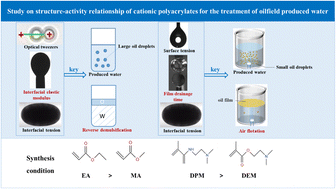Study on the structure–activity relationship of cationic polyacrylates for the treatment of oilfield produced water
Abstract
Cationic polyacrylates exhibit both reverse demulsification and flotation performance, which can avoid incompatibility between the reverse demulsifier and flotation agent during treatment of produced water from offshore oilfields. In our previous work, the effect of the structure of the cationic unit on the reverse demulsification and flotation performance of cationic polyacrylates was studied. However, the structure–activity relationship of cationic polyacrylates has not been systematically studied. In this study, the relationships between the structure (acrylate type, tertiary amine type, mass ratio of acrylate to tertiary amine, and degree of cationicity), interfacial properties (surface tension, interfacial tension, zeta potential, interfacial elastic modulus, interaction force between oil droplets, and film drainage time of an oil-covered bubble), and reverse demulsification and flotation performance of cationic polyacrylates were investigated. A reduction in the elastic modulus of the oil–water interface was the key factor for good reverse demulsification performance, whereas a decrease in the film drainage time of an oil-covered bubble was the key factor for good flotation performance. Ethyl acrylate (EA) was superior to methyl acrylate (MA), and dimethylaminopropyl methacrylamide (DPM) was superior to dimethylaminoethyl methacrylate (DEM). Increases in the mass ratio of ethyl acrylate to dimethylaminopropyl methacrylamide and the degree of cationicity were beneficial for reducing the elastic modulus of the oil–water interface and the film drainage time of an oil-covered bubble. This is the first time that the structure–property–performance relationship of cationic polyacrylates has been systematically studied. A cationic polyacrylate that exhibited both good reverse demulsification performance and good flotation performance is recommended.



 Please wait while we load your content...
Please wait while we load your content...